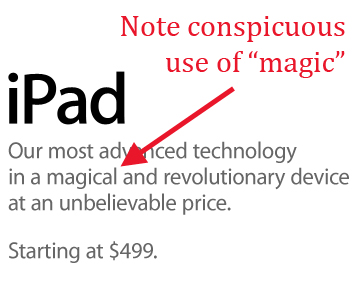
- Image by Tom Raftery via Flickr
The introduction of the iPad marks the beginning of the end of price controls for ebooks, but not because, as some have speculated, Apple’s more flexible pricing controls in the iBooks store provide leverage against Amazon. Of course, Apple’s more flexible pricing controls do provide leverage against Amazon. As David Crotty observed in a recent Scholarly Kitchen post, Macmillan wasted no time in applying that leverage. But Macmillian’s skirmish with Amazon strikes me as a battle waged after the war has already been decided (which perhaps explains why Jeff Bezos was absent from the battlefield as John Scalzi has noted in a blistering critique of Amaon’s handling of the situation).
The real reason the iPad marks the end of pricing controls for ebooks has nothing to do with Apple’s iBooks pricing policy. In fact, the iPad renders Apple’s own ebook pricing policy as irrelevant as Amazon’s. The real reason the iPad renders any ebook pricing policy irrelevant is because the iPad is not a dedicated ebook reader.
Why does this matter? It matters because unlike the Kindle (and unlike the iPod when it comes to music), there are multiple paths publishers can take to deliver content to the device.
It is important to disambiguate iBooks from iPad. iBooks is Apple’s as-yet-to-be-launched online store for ebooks. Presumably iBooks will occupy another tab in the increasingly misnamed iTunes Store. Already there are tabs for the App Store, Audiobooks, and iTunes U along side Music, Movies, TV Shows, and Podcasts. Just as the App Store has long had its own app on the iPhone, iBooks will have its own app on the iPad (and iPhone/iPod Touch). Essentially this app will access just the iBooks tab in the iTunes Store.
In introducing iBooks, Apple is using a move from its own playbook. When the iPod launched and Apple first introduced the (then appropriately named) iTunes Store, Apple set price controls on the music it sold. There were a lot of reasons for this. Apple was competing against “free,” which was the price most people were paying for music obtained online at that point in time. A simple pricing model was the way to go.
Apple also was (and is) in the device business. The easier and cheaper they make it buy music, the more people will buy iPods. The more people who buy iPods, the more music they will collectively buy. And so on (the “Infinite Loop” strategy if you will).
Perhaps most importantly, Apple had (and arguably still has) a de facto monopoly on the legal online distribution of music and so could get away with it.
But music and books are not the same thing, and Apple is not in the same position with regard to ebooks.
Apple is not competing against “free” in the same sense it was (and indeed still is) when it launched iTunes. While libraries do, of course, circulate free books, Apple is competing for the people who prefer to own books or who prefer to read electronic books (which, in many cases, are not available to library patrons). Such readers are used to paying variable prices for books. Apple does not need to do anything except allow book-buying customers to replicate their current behavior.
But there is a far more important distinction between Apple’s foray into books versus music. When the iPod launched, there was only one way to get music on the device—iTunes. You could buy music via iTunes or rip CDs into iTunes. In either event, you needed iTunes (and you still do—Apple has effectively very little competition to this day).
Unlike music publishers, book publishers have not one but at least five ways to deliver content to the iPad:
- The iBooks Store – Publishers can submit ebooks in EPUB format to the iBook store. In this case, publishers would need to agree to Apple’s rules regarding pricing (at least for now).
- Build an app – There are many books that already have their own apps. While developing a bespoke app for each book would be cost prohibitive, there is nothing to prevent a publisher from developing a standard app into which they flow a large number their titles (like a template or a set of templates). Penguin could, for example, build an app for their entire line of literature classics. The app itself would be free but then users could purchase individual titles within the app. There would be no price restrictions on such purchases.
- Use a third-party app – There is nothing to prevent Barnes & Noble, Safari Books, Baker & Taylor, Ingram, Smashwords, Scribd, and others from developing their own apps to deliver ebook content to the iPad. Amazon already has one for the iPhone which will presumably deliver ebooks to the iPad on Day One. Again, there are no price restrictions on such purchases (except for those imposed by the third party).
- Use your Web site – Most ebooks are currently read online via PCs. As Steve Jobs emphasized repeatedly in his recent keynote, the iPad is designed to be a great Web interface. Publishers can put their books online, behind an access wall if they’d like, and readers can access them online via the iPad. Alternatively, publishers can simply sell the PDF files they already have via their Web sites, which I imagine will look very nice on the iPad. Not only are there no price restrictions using this method, but there is no revenue share.
- Third-party Web sites – These might include Google Editions, Scribd, or any other online ebook seller that sells or displays ebooks for the Web.
Of these five paths to the iPad, only the iBooks Store has any (Apple-imposed) price restrictions. But Apple will be forced to remove even the iBooks price restrictions in the very near future.
Apple will face increasing pressure from publishers using the other four channels outside of iBooks to deliver content to the iPad. Scholarly and professional publishers, who have long been utilizing the Web for ebook delivery, may very well lead the way on this front.
A little pressure will be enough because the price point for ebooks is really not important to Apple for the simple reason that iBooks is not the center of gravity for this device. The only reason anyone bought an iPod (until the launch of the iPod Touch anyway) was to listen to music. The only reason anyone bought a Kindle was to read ebooks. It was important to establish just the right (from the device-maker’s perspective) price point for content on these devices. Reading ebooks is not the only—or even primary—reason most people will buy an iPad. At the moment, Apple wants to woo Kindle users and so needs to ensure that ebooks are not substantively more expensive in iBooks than via Amazon. But in a few months, as ebooks make their way onto the iPad via other routes, as native applications are built for the iPad, and as Amazon grudgingly retracts their pricing policies in order to ensure they receive top tier ebooks upon release, Apple’s pricing policy, flexible as it is, will evaporate.
 The other factor to bear in mind is that, while Apple may be first to market with a “magical” tablet (computer makers, including Apple, seem to dip their toes in the water every few years with a tablet of some kind, but they have all previously neglected to include magic, thus ensuring their failure—duh!), they will not have the market to themselves for long. Amazon has already purchased a company that makes touch screens and is rumored to be working on a “SuperKindle.” Sony is hardly one to shirk from a fight. Microsoft has been not-so-secretly developing a new two-screen tablet for some time. Google is now in the device business and has its own mobile OS. Then there is Dell, HP, Leveno, Barnes & Noble—the list goes on.
The other factor to bear in mind is that, while Apple may be first to market with a “magical” tablet (computer makers, including Apple, seem to dip their toes in the water every few years with a tablet of some kind, but they have all previously neglected to include magic, thus ensuring their failure—duh!), they will not have the market to themselves for long. Amazon has already purchased a company that makes touch screens and is rumored to be working on a “SuperKindle.” Sony is hardly one to shirk from a fight. Microsoft has been not-so-secretly developing a new two-screen tablet for some time. Google is now in the device business and has its own mobile OS. Then there is Dell, HP, Leveno, Barnes & Noble—the list goes on.
With all these tablets—all with multiple routes of content delivery for publishers—device makers will not be able to maintain price controls. There will be too much competition and too many routes to content delivery.
Victory: Publishers.
Before we break out the champagne and celebrate, there is one small wrinkle to consider, which I explore tomorrow in a follow-up post:
“Why the iPad Marks the End of Price Controls for eBooks—and Why Publishers Have Lost“
Discussion
12 Thoughts on "Why the iPad Marks the End of Price Controls for eBooks—and Why Publishers Have Won"
Really interesting, thank you.
Wow, what an opportunity here while the hardware market is growing. Publishers and device makers working together could then create a “Harry Potter” effect – the virtual equivalent of queues outside bookstores at midnight.
Imagine if the next Dan Brown book was available only through iBook for the first two months, what effect would this have on iPad sales? Perhaps one book isn’t enough of an incentive but there must be a way to do this. If Apple were prepared to share some percentage of their profits with the publisher this could work well for both parties. Neat.
Perhaps I missed it but this is the first time I read someone pointing out that when Apple introduced the I-pod it was competing with “free.” Very interesting.
A couple of thoughts to add:
First, it is possible to use an iPod without using iTunes. Details here, here, here, and here. Though given this recent example, it’s unlikely that any of these are feasible options for most computer users, so in essence, your point is accurate, using an iPod means using iTunes.
It’s interesting to note that the iPad won’t come with the iBooks app, it must be separately downloaded.
Using options 2 and 3 (build your own or use someone else’s app and then sell content through that)–you will get around Apple’s price restrictions, but you are still beholden to Apple’s rules and to giving them the same 30% cut of revenue.
I’m willing to bet that we’re going to see an additional model, one that combines several of the ones you mentioned. Build your own free app for reading the books, but only sell the actual books through your own website. This is how Amazon’s Kindle app currently works. You have to go to the Amazon website through a web browser to buy a book, you can’t buy anything through the Kindle app. But once bought, you can access your purchases through the specialized app. This adds a clunky step into the process, but lets resellers avoid giving Apple any share of revenue from book sales.
I’m also convinced that we’ll see a separate set of terms coming from Apple regarding the textbook market. Apple seems very keen to use the iPad as an entry to this market, and to push it more into the electronic realm. Apple has always had a strong presence in education. Given that the textbook market has a different pricing structure than the popular books market, I think Apple will have a different, more flexible set of terms for this valuable market. Wooing the textbook publishers is important if Apple wants to put an iPad in every student’s backpack.
That is very interesting that the iBooks app will not be pre-installed on the iPad. I had assumed it would given that it was one of the “Apple apps” featured in the iPad launch presentation. Further evidence that ebooks are not the center of gravity for Apple’s iPad strategy.
I agree that the free “ebook reader app” – with actual ebooks purchased elsewhere – is likely to be a common strategy so as to avoid the 30% Apple commission.
It will indeed be interesting to see how Apple approaches the textbook market. As you point out, they clearly understand the education market better than other device makers. With their color images, quizzes, worksheets, and references, textbooks really need a multi-function tablet such as the iPad. The Kindle just does not do them justice.
That being said, I don’t think that the iPad will be able to replace the laptop in the backpacks of students. While it may be a great device for reading, videos, and Web browsing, I don’t see it being so popular for writing term papers. Will students be willing to pay for a secondary device such as the iPad? Alternately, might there be another business model whereby tablets are bundled with textbook purchases and appear to be free to the student?
I am interested in providing an alternative book reading App to people downlowding ePub through iBook. Do you think Apple will allow multiple Readers accessing iBook on iPad, or will we be locked into the Apple Reader?
It’s been reported that Apple’s iBookstore will sell books wrapped in Apple’s FairPlay DRM. Since Apple hasn’t licensed this to anyone else in any other arena, I’m assuming they won’t license it here, and if you want to read a purchase from the iBookstore, you will need to use Apple’s iBook App (or purchase DRM-free content from the store, which is apparently an option for publishers).
That said, I expect to see a wide variety of readers available for books purchased from different places in different file formats.
Mike –
It struck me while reading this post that there is a whole other market of readers no one is talking about – ME! Someone that isn’t a Kindle/SONY/Nook etc purchaser and never will be because I don’t read eBooks (although I read everything but books on line and on my iPhone).
My point – the iPad will get me started on eBooks and I won’t be used to paying 9.99 I’ll be used to paying for a physical book. I won’t care in many cases if my ebook is $14.99. I’ll just care that I got it for the best price I could.
All of us that won’t buy a single purpose device and, perhaps as a result, haven’t really gotten into ebooks may well give them a try on the iPad.
Ann
That’s why this is such an urgent and immediate issue for publisher now. Only a very small minority had adopted eBooks, and they’ve made it very clear how set they are on a seemingly arbitrary price ($9.99) that’s being pushed by one vendor. If there’s going to be any flexibility in pricing, it needs to be established now before the market is cemented in place, before the general book reading public join in.
Your comment though, made me think of the Nintendo Wii, which is an apt comparison for the iPad. It’s a less technical version of an already existing product that seems to have pulled in a much wider audience.
Ann:
I appreciate your comments. There is a large market of readers like you. On the other end of the spectrum there is also a market for readers like myself. I have been reading eBooks for years. Like you, my concern is not price. My frustration is about being able to get the book I want to read in eBook format.
Now is certainly the time for publishers to establish flexibility in pricing. This will give people like yourself a fair price compared to print and will hopefully allow publishers to create eBooks profitably so that I can get the books I want to read.
David
![Reblog this post [with Zemanta]](http://img.zemanta.com/reblog_e.png?x-id=786e38d4-fd12-49ad-be66-35910baa18e0)


